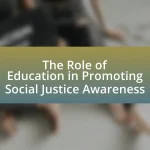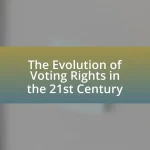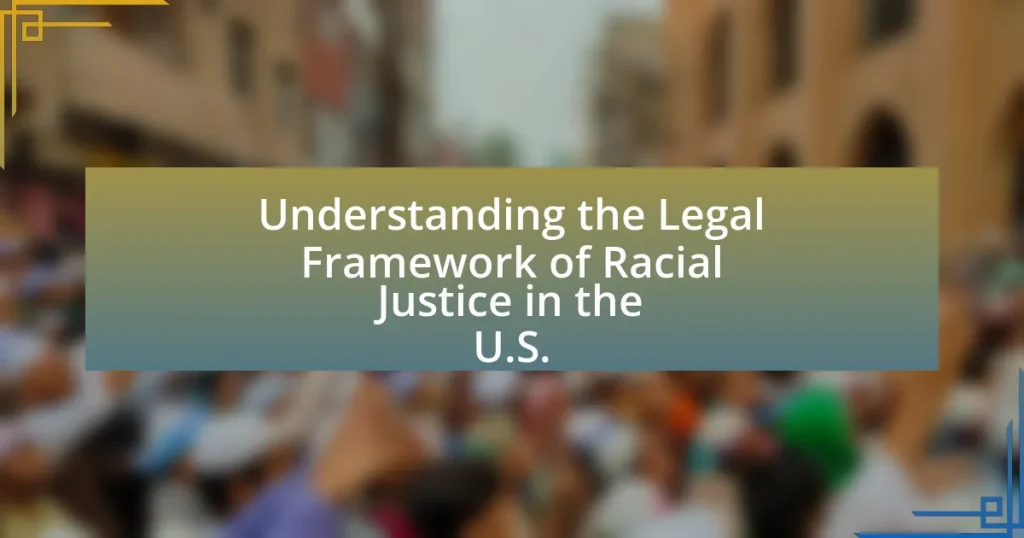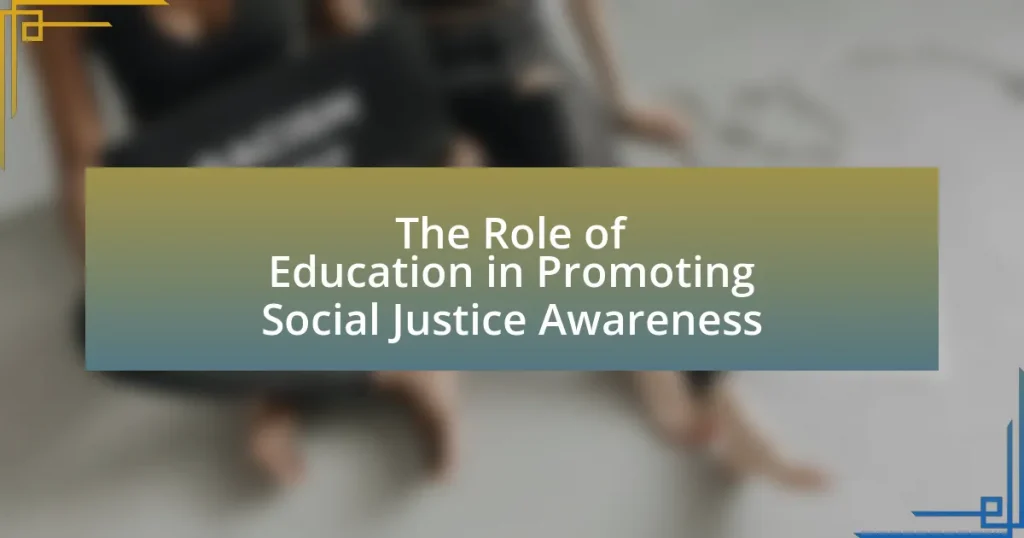The article provides a comprehensive overview of the legal framework of racial justice in the United States, detailing the federal laws, constitutional amendments, and landmark Supreme Court decisions that prohibit racial discrimination and promote equality. Key components include the Civil Rights Act of 1964, the Voting Rights Act of 1965, and the 14th Amendment, which collectively shape ongoing efforts to address racial injustices. The article also examines the evolution of this framework over time, the influence of historical events and Supreme Court rulings, and the current challenges faced by marginalized communities in accessing justice. Additionally, it discusses the role of public policy, grassroots movements, and education in advancing racial equity and highlights the need for continued reform to combat systemic inequalities.
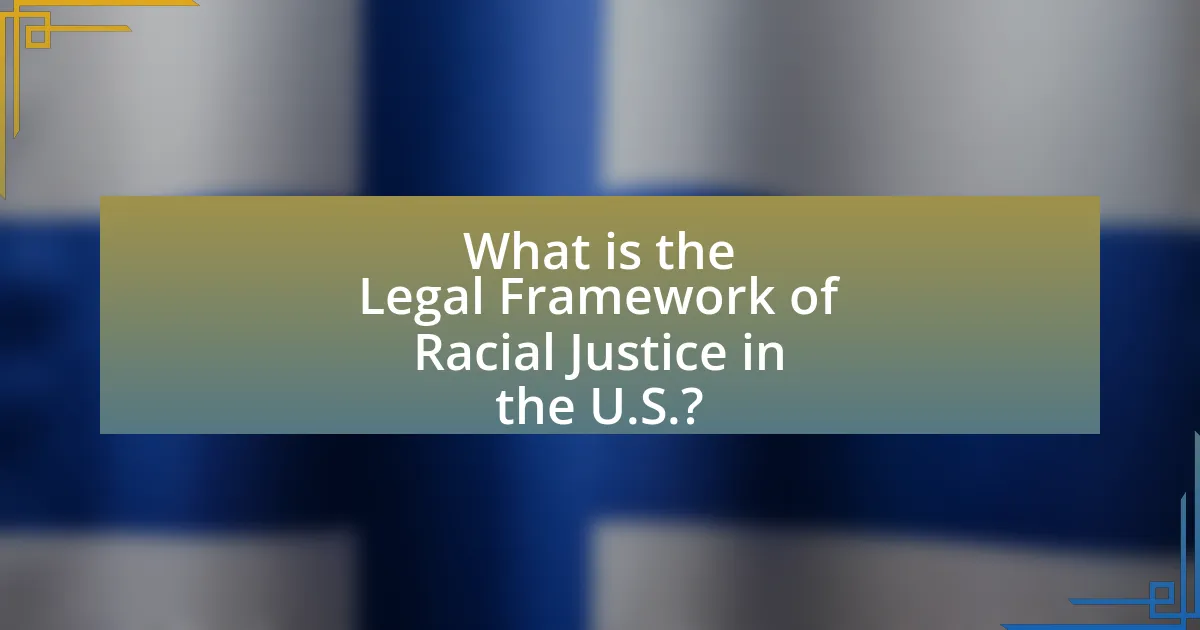
What is the Legal Framework of Racial Justice in the U.S.?
The legal framework of racial justice in the U.S. is primarily established through a combination of federal laws, constitutional amendments, and landmark Supreme Court decisions aimed at prohibiting racial discrimination and promoting equality. Key components include the Civil Rights Act of 1964, which outlawed discrimination based on race, color, religion, sex, or national origin, and the Voting Rights Act of 1965, which aimed to eliminate barriers to voting for African Americans. Additionally, the 14th Amendment guarantees equal protection under the law, reinforcing the principle of racial equality. Landmark cases such as Brown v. Board of Education (1954) declared racial segregation in public schools unconstitutional, further shaping the legal landscape for racial justice. These laws and judicial rulings collectively form the foundation for ongoing efforts to address and rectify racial injustices in the United States.
How has the legal framework evolved over time?
The legal framework of racial justice in the U.S. has evolved significantly from the pre-Civil War era to the present day. Initially, laws such as the Slave Codes enforced racial discrimination and slavery, while the post-Civil War Reconstruction Amendments, particularly the 13th, 14th, and 15th Amendments, aimed to abolish slavery and establish citizenship and voting rights for African Americans. The Civil Rights Movement of the 1960s led to landmark legislation, including the Civil Rights Act of 1964 and the Voting Rights Act of 1965, which prohibited discrimination based on race and ensured voting rights. Recent developments include ongoing legal battles over affirmative action, police reform, and voting access, reflecting the continuing struggle for racial equity. This evolution demonstrates a shift from overt legal discrimination to a more complex legal landscape addressing systemic inequalities.
What key historical events shaped racial justice laws?
Key historical events that shaped racial justice laws include the Emancipation Proclamation of 1863, which abolished slavery in the Confederate states, and the Civil Rights Act of 1964, which prohibited discrimination based on race, color, religion, sex, or national origin. The Reconstruction Amendments, particularly the 14th Amendment in 1868, established citizenship and equal protection under the law for all persons, significantly influencing future racial justice legislation. Additionally, landmark Supreme Court cases such as Brown v. Board of Education in 1954, which declared racial segregation in public schools unconstitutional, played a crucial role in advancing racial justice laws. These events collectively laid the groundwork for ongoing efforts toward racial equality and justice in the United States.
How have Supreme Court decisions influenced racial justice?
Supreme Court decisions have significantly influenced racial justice by establishing legal precedents that either advanced or hindered civil rights. Landmark cases such as Brown v. Board of Education (1954) declared racial segregation in public schools unconstitutional, thereby promoting desegregation and equality in education. Conversely, decisions like Shelby County v. Holder (2013) weakened the Voting Rights Act, leading to increased voter suppression in minority communities. These rulings demonstrate the Court’s pivotal role in shaping the landscape of racial justice in the United States, impacting legislation and societal norms surrounding race relations.
What are the main components of the legal framework?
The main components of the legal framework include statutes, regulations, case law, and constitutional provisions. Statutes are laws enacted by legislatures, such as the Civil Rights Act, which prohibits discrimination based on race. Regulations are rules created by governmental agencies to implement statutes, like those enforced by the Equal Employment Opportunity Commission. Case law consists of judicial interpretations and rulings that establish legal precedents, such as landmark Supreme Court decisions like Brown v. Board of Education, which addressed racial segregation. Constitutional provisions, including the Equal Protection Clause of the Fourteenth Amendment, provide foundational legal protections against racial discrimination. These components collectively shape the legal landscape for racial justice in the U.S.
What federal laws address racial justice issues?
The federal laws that address racial justice issues include the Civil Rights Act of 1964, the Voting Rights Act of 1965, and the Fair Housing Act of 1968. The Civil Rights Act prohibits discrimination based on race, color, religion, sex, or national origin in various areas, including employment and public accommodations. The Voting Rights Act aims to eliminate barriers to voting for African Americans and other minority groups, ensuring their right to participate in elections. The Fair Housing Act prohibits discrimination in housing based on race, color, religion, sex, or national origin, promoting equal access to housing opportunities. These laws collectively form a critical legal framework aimed at advancing racial justice in the United States.
How do state laws vary in their approach to racial justice?
State laws vary significantly in their approach to racial justice, with some states enacting comprehensive anti-discrimination laws while others have minimal protections. For instance, California has robust civil rights protections, including the California Fair Employment and Housing Act, which prohibits discrimination based on race, while states like Alabama have fewer protections and often rely on federal laws. Additionally, states differ in their implementation of police reform measures; for example, New York has enacted legislation aimed at increasing police accountability, whereas other states may lack similar reforms. These variations reflect differing political climates, historical contexts, and public attitudes toward racial justice across the United States.
Why is understanding this framework important?
Understanding the legal framework of racial justice in the U.S. is crucial because it provides the foundational knowledge necessary to address systemic inequalities and advocate for equitable policies. This framework encompasses key legislation, judicial decisions, and historical contexts that shape the current landscape of racial justice. For instance, landmark cases like Brown v. Board of Education and legislation such as the Civil Rights Act of 1964 illustrate the legal mechanisms that have been employed to combat racial discrimination. By comprehending these elements, individuals and organizations can effectively engage in informed advocacy, contribute to policy reform, and promote social justice initiatives that aim to dismantle systemic racism.
How does the legal framework impact marginalized communities?
The legal framework significantly impacts marginalized communities by shaping their access to rights, resources, and protections. For instance, laws such as the Voting Rights Act of 1965 aimed to eliminate racial discrimination in voting, directly benefiting marginalized groups by enhancing their political representation. Conversely, systemic issues like discriminatory laws and practices, such as redlining and mass incarceration, have perpetuated inequalities, limiting economic opportunities and social mobility for these communities. Research indicates that marginalized groups often face barriers in legal recourse, as seen in studies highlighting disparities in legal aid access and outcomes in court systems. These factors illustrate how the legal framework can either empower or further disenfranchise marginalized communities.
What role does public policy play in racial justice?
Public policy plays a crucial role in advancing racial justice by establishing laws and regulations that address systemic inequalities and promote equitable treatment. For instance, policies such as the Civil Rights Act of 1964 and the Fair Housing Act of 1968 were instrumental in prohibiting discrimination based on race in various sectors, including employment and housing. These legislative measures have been foundational in dismantling institutional barriers that perpetuate racial disparities, thereby fostering a more just society. Additionally, public policy initiatives aimed at criminal justice reform, such as the decriminalization of certain offenses and the implementation of community policing strategies, further contribute to reducing racial bias within law enforcement practices.

What are the current challenges within the legal framework?
Current challenges within the legal framework of racial justice in the U.S. include systemic bias, inadequate enforcement of existing laws, and disparities in legal representation. Systemic bias manifests in various forms, such as racial profiling and discriminatory sentencing practices, which disproportionately affect minority communities. Inadequate enforcement of laws designed to protect civil rights, such as the Voting Rights Act, has led to increased voter suppression tactics that disproportionately impact racial minorities. Additionally, disparities in legal representation arise from socioeconomic factors, where individuals from marginalized communities often lack access to quality legal counsel, resulting in unequal outcomes in the justice system. These challenges highlight the need for comprehensive reforms to address inequities and ensure justice for all.
How do systemic inequalities manifest in legal practices?
Systemic inequalities manifest in legal practices through biased enforcement of laws, unequal access to legal representation, and disparities in sentencing. For instance, studies show that marginalized communities, particularly people of color, face higher rates of police stops and arrests compared to their white counterparts, reflecting a discriminatory application of law enforcement. Additionally, research indicates that individuals from lower socioeconomic backgrounds often cannot afford adequate legal representation, leading to unfavorable outcomes in court. Furthermore, data from the U.S. Sentencing Commission reveals that Black defendants receive longer sentences than white defendants for similar offenses, highlighting racial disparities in sentencing practices. These factors collectively illustrate how systemic inequalities are embedded within the legal framework, affecting the pursuit of racial justice in the U.S.
What are the barriers to accessing justice for racial minorities?
Barriers to accessing justice for racial minorities include systemic discrimination, economic disparities, and lack of legal representation. Systemic discrimination manifests in biased policing practices and judicial processes that disproportionately affect racial minorities, leading to mistrust in the legal system. Economic disparities hinder access to legal resources, as many racial minorities may lack the financial means to afford legal representation or navigate complex legal systems. Additionally, the shortage of culturally competent legal services further exacerbates these challenges, as racial minorities may struggle to find attorneys who understand their unique circumstances. According to a report by the American Bar Association, racial minorities are significantly underrepresented in legal professions, which contributes to the inequities in access to justice.
How do biases in law enforcement affect racial justice?
Biases in law enforcement significantly undermine racial justice by perpetuating systemic discrimination against marginalized communities. These biases manifest in practices such as racial profiling, which leads to disproportionate targeting of individuals based on race rather than behavior. For instance, a 2013 study by the American Civil Liberties Union found that Black individuals are nearly four times more likely to be stopped by police than white individuals, despite similar rates of drug use across racial groups. This unequal treatment not only erodes trust between law enforcement and communities of color but also results in harsher legal consequences for these populations, contributing to a cycle of disadvantage and injustice.
What are the criticisms of the existing legal framework?
The existing legal framework for racial justice in the U.S. faces several criticisms, primarily for its inadequacy in addressing systemic racism and inequality. Critics argue that laws often fail to provide effective remedies for discrimination, as seen in cases where legal protections do not extend to all marginalized groups. Additionally, the enforcement of existing laws is inconsistent, leading to disparities in outcomes, particularly in policing and sentencing practices. Research by the American Civil Liberties Union highlights that Black individuals are disproportionately affected by harsh sentencing laws, which underscores the framework’s shortcomings. Furthermore, the legal system is criticized for being overly complex and inaccessible, making it difficult for affected individuals to seek justice. These criticisms point to a need for comprehensive reform to ensure that the legal framework effectively promotes racial equity and justice.
What arguments do activists make against current laws?
Activists argue that current laws perpetuate systemic racism and inequality, undermining the principles of justice and fairness. They contend that laws such as mandatory minimum sentencing disproportionately affect communities of color, leading to higher incarceration rates. For instance, the Sentencing Project reports that Black Americans are incarcerated at more than five times the rate of white Americans, highlighting the racial disparities in the criminal justice system. Additionally, activists claim that voter ID laws and gerrymandering practices disenfranchise minority voters, further entrenching racial inequities in political representation. These arguments are supported by studies indicating that such laws disproportionately impact marginalized communities, limiting their access to essential rights and resources.
How do critics propose to reform the legal framework?
Critics propose to reform the legal framework by advocating for comprehensive legislative changes that address systemic inequalities and promote racial justice. They emphasize the need for laws that dismantle discriminatory practices within the criminal justice system, such as mandatory minimum sentences and racial profiling. Additionally, critics call for the implementation of restorative justice practices that focus on rehabilitation rather than punishment, aiming to reduce recidivism rates among marginalized communities. Evidence from studies indicates that jurisdictions adopting such reforms have seen improvements in community relations and reductions in incarceration rates, supporting the effectiveness of these proposed changes.

What are the future directions for racial justice in the U.S.?
Future directions for racial justice in the U.S. include comprehensive policy reforms, increased community engagement, and enhanced accountability measures for law enforcement. Policymakers are focusing on enacting legislation that addresses systemic inequalities, such as the George Floyd Justice in Policing Act, which aims to limit police misconduct and improve transparency. Community organizations are advocating for grassroots movements that empower marginalized voices, ensuring that those affected by racial injustice have a platform to influence change. Additionally, there is a growing emphasis on data collection and analysis to hold institutions accountable, as evidenced by the push for better reporting on police interactions and racial disparities in various sectors. These directions reflect a collective effort to create a more equitable society by addressing the root causes of racial injustice.
How can legal reforms promote racial equity?
Legal reforms can promote racial equity by dismantling systemic barriers and ensuring equal protection under the law. For instance, the Civil Rights Act of 1964 prohibited discrimination based on race, color, religion, sex, or national origin, which significantly advanced racial equity in employment and public accommodations. Additionally, reforms such as the Fair Housing Act of 1968 aimed to eliminate racial discrimination in housing, contributing to more equitable access to housing opportunities. These legal changes create a framework that holds individuals and institutions accountable, thereby fostering an environment where racial equity can be pursued and achieved.
What role do grassroots movements play in shaping future laws?
Grassroots movements play a crucial role in shaping future laws by mobilizing community support and advocating for policy changes that reflect the needs and values of marginalized groups. These movements often raise awareness about social injustices, influencing public opinion and prompting lawmakers to address specific issues. For instance, the Civil Rights Movement of the 1960s, driven by grassroots activism, led to significant legislative changes such as the Civil Rights Act of 1964 and the Voting Rights Act of 1965, which aimed to eliminate racial discrimination. By organizing protests, campaigns, and community discussions, grassroots movements create pressure on political leaders to enact laws that promote racial justice and equality.
How can education and awareness contribute to change?
Education and awareness can significantly contribute to change by equipping individuals with knowledge about racial justice issues and the legal framework surrounding them. This understanding fosters critical thinking and encourages informed discussions, which can lead to advocacy for policy reforms. For instance, studies have shown that educational programs focused on racial equity increase awareness of systemic injustices, leading to greater civic engagement and participation in movements for change. According to a report by the American Psychological Association, educational interventions that address racial bias can reduce prejudice and promote social justice, demonstrating the tangible impact of education on societal attitudes and behaviors.
What practical steps can individuals take to support racial justice?
Individuals can support racial justice by actively engaging in advocacy, education, and community involvement. Advocacy includes participating in peaceful protests, contacting elected officials to express support for racial justice legislation, and supporting organizations that work towards racial equity. Education involves learning about systemic racism, understanding the history of racial injustice in the U.S., and sharing this knowledge with others to raise awareness. Community involvement can take the form of volunteering with local organizations that promote racial justice, supporting minority-owned businesses, and fostering inclusive environments in personal and professional spaces. These actions contribute to a collective effort to dismantle systemic racism and promote equality.
How can community engagement influence legal reforms?
Community engagement can significantly influence legal reforms by providing a platform for marginalized voices to be heard, thereby shaping policy decisions. When communities actively participate in discussions about legal issues, they can highlight specific injustices and advocate for changes that reflect their needs. For instance, grassroots movements have historically led to reforms in areas such as voting rights and criminal justice, demonstrating the power of collective action. Research shows that community-led initiatives, like the Civil Rights Movement, resulted in landmark legislation such as the Civil Rights Act of 1964, which addressed systemic racial discrimination. This illustrates that when communities mobilize and engage with lawmakers, they can drive substantial legal changes that promote racial justice and equity.
What resources are available for learning about racial justice laws?
Resources for learning about racial justice laws include academic institutions, legal organizations, and online platforms. Universities such as Harvard Law School and Yale Law School offer courses and materials focused on racial justice and civil rights law. Organizations like the American Civil Liberties Union (ACLU) and the NAACP provide extensive resources, including reports, legal analyses, and educational materials on racial justice issues. Online platforms such as Coursera and edX offer courses on civil rights law and social justice, often created by reputable universities. These resources are validated by their affiliation with established educational and legal entities, ensuring accurate and comprehensive information on racial justice laws.

